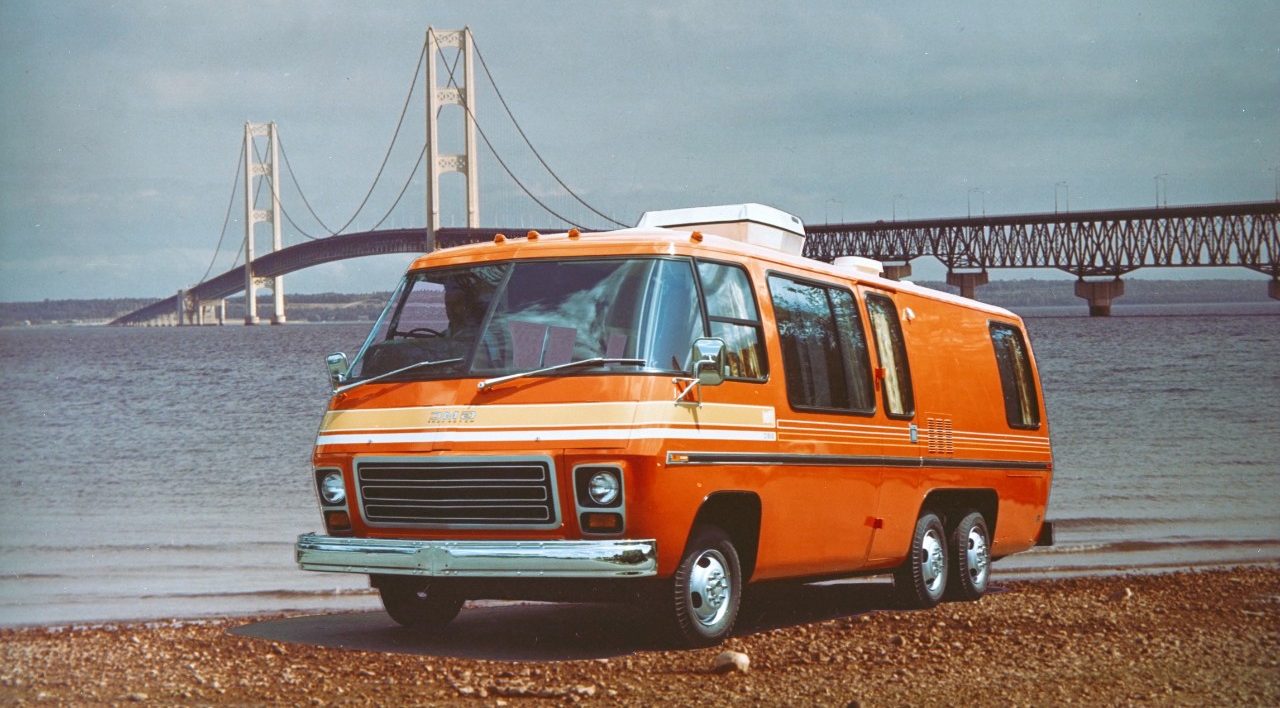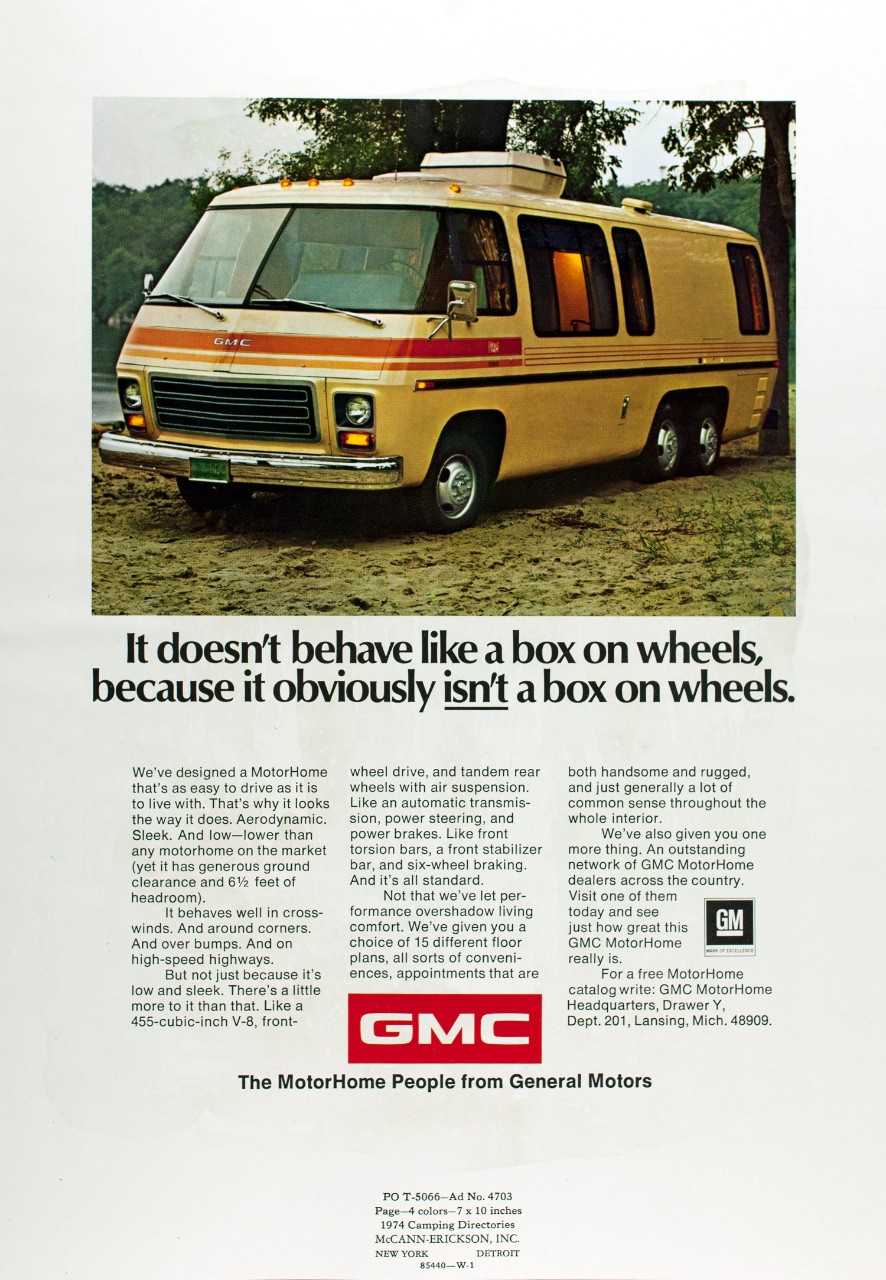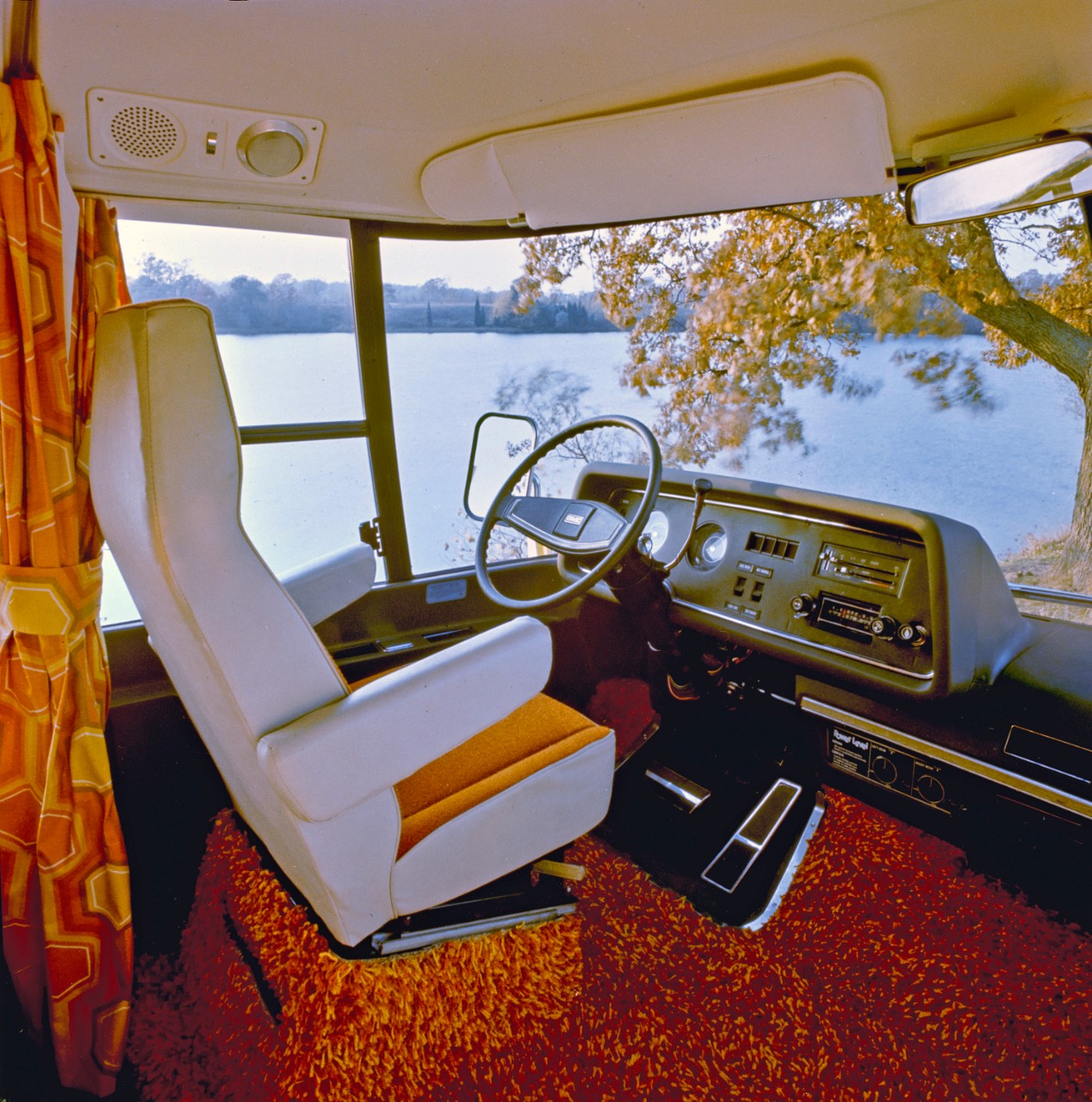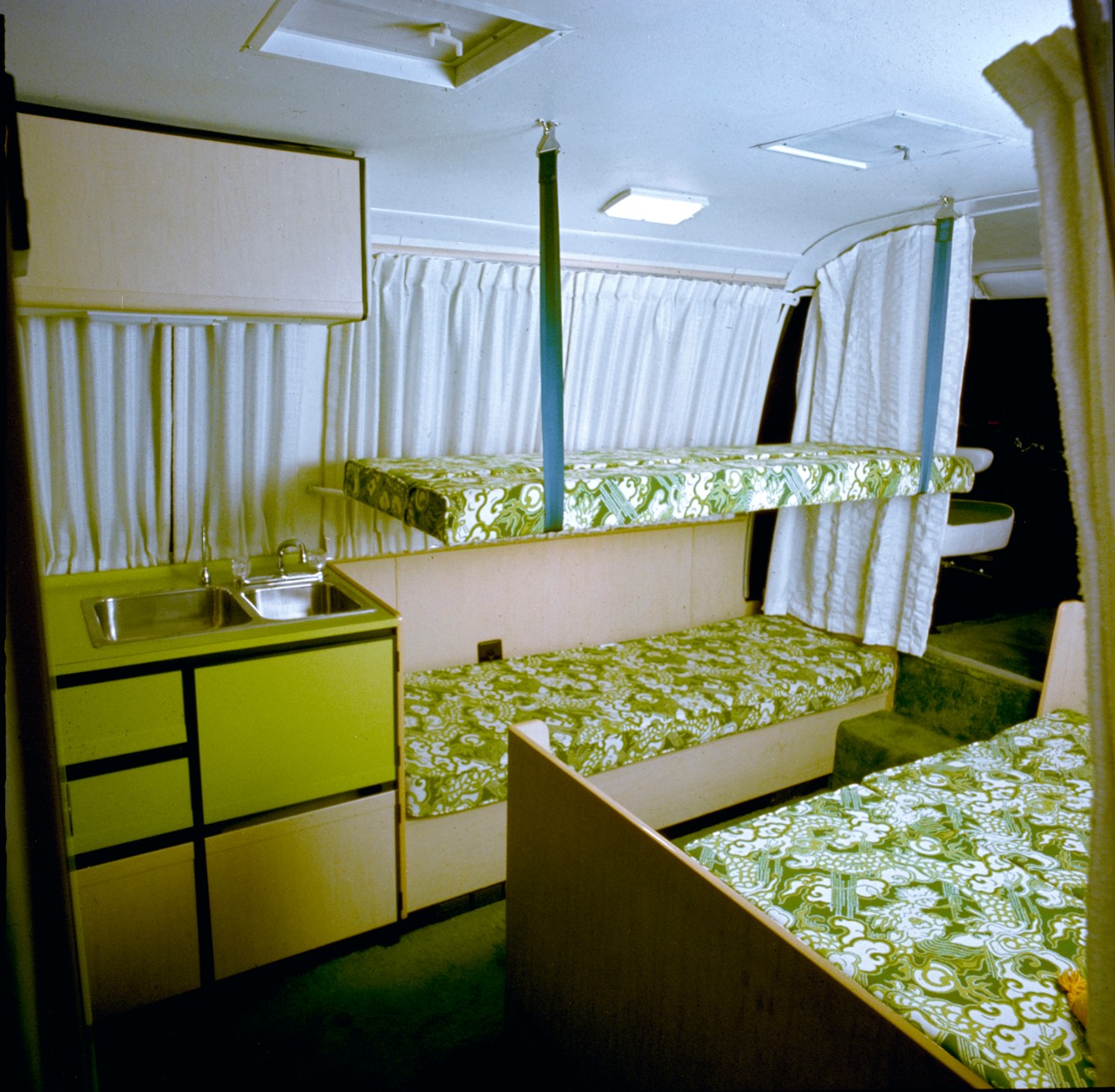By Eric J. Savitz, editor-in-chief, GM News
By Eric J. Savitz, editor-in-chief, GM News
One of many astonishing things about the iconic recreational vehicle known as the GMC Motorhome is how many are still on the road. Over the course of five years, from 1973 to 1978, General Motors built 12,921 of them. Vehicle registration data collected by one Motorhome enthusiast group shows close to 9,000 – about 70% - in operation as of 2023.
That seems preposterous. GMC Motorhomes are roughly 50 years old. The average car on the road is 12.6 years old, according to S&P Global Mobility. To state the obvious, not many ’70s cars are still in service. But this is no ordinary vehicle.
Consider: Around the country, there are multiple businesses dedicated specifically to refurbishing and maintaining GMC Motorhomes. Every month, Motorhome owners gather at meetups by the hundreds to share maintenance tips and admire each other’s vehicles. There’s a GMC Motorhome Facebook group with more than 16,000 members – the membership exceeds the number of Motorhomes ever built.
And again, this isn’t for a legendary sports car like the Chevy Corvette, or a muscle car like the Buick GNX. This is an RV.
Stylin’
Are you puzzled? Don’t be.
“It boils down to one thing: design,” explains Karen Breen, who has edited a Motorhome-focused magazine called Roam for the GMC Great Lakers, an enthusiasts group.
Caption: Karen Breen outside her 1978 GMC Motorhome.
“It was the coolest thing ever produced,” says Breen, a former Motorhome owner from Birmingham, Michigan who recently sold her beloved vehicle for triple what she paid for it. And she was the fifth owner. “When I was a kid, we would drool, we would stop in our tracks and watch this thing go by. The windows, the shape…it was ahead of its time, and it’s never lost its style.”
Caption: A print ad for the GMC Motorhome.
She’s not the only one who thinks so.
“It has such classic lines,” says Lucy Weidner, the president of GMC Motorhomes International, a hobbyist group with 1,000 members, which holds gatherings for owners every year. (This September, there’s a rally scheduled for Traverse City, Michigan.) Weidner says she and her husband Larry Weidner have put close to 200,000 miles on their 1978 Motorhome, a model called the Royale, which they bought in 2001.
The Weidners drive their Motorhome regularly from their home in Menomonie, Wisconsin to see family in Florida. “It has stood the test of time,” she says. “When we pull into a gas station or park, people cover over to see it. It’s quite the conversation starter.”
Not just a big box
General Motors announced plans to enter the RV market in 1972, at a time when demand for homes on wheels was soaring. A few months after that announcement, the New York Times reported that 1972 RV sales were expected to grow 90%. There were dozens of competitors, most of them building RVs on truck chassis – big, ugly, high-profile boxes.
GM saw an opportunity.
Martin Caserio, then VP and general manager of GMC Truck & Coach, a unit producing buses for local and intercity transportation, disclosed in the press release announcing GM’s plans that the new vehicle would feature front-wheel drive, a low-frame chassis, and an aluminum and fiberglass body – all features at odds with the average boxy RV of the era.
GM demonstrated a prototype at Transpo 72, the U.S. International Transportation Expo, a historic trade show held at Dulles International Airport outside Washington. Hosted by the U.S. Department of Transportation, the event also featured passenger jets, high speed rail, buses, and a U.S. Coast Guard hovercraft. The media got their first look at the production version of the GMC Motorhome in January 1973, at an event in Anaheim Stadium. And right from the start, the design created a stir.
What made the Motorhome memorable – and explains why so many are still around half a century later – is that it looked fantastic. It was the epitome of Midwestern cool.
“Finally, a motorhome that doesn’t look like a box or ride like a truck,” reads the headline on a brochure GM distributed for the 1973 edition GMC Motorhome. And they weren’t kidding – it looked like nothing else on the market.
GM equipped the Motorhome with the same front-wheel drive powertrain and 455-cubic-inch Rocket V8 used in the Oldsmobile Toronado, a mid-sized luxury car produced by GM from 1966 to 1992. (GMC switched the Motorhome to a smaller 403-cubic-inch engine in 1977 when GM stopped making the 455.) The engine was mounted longitudinally, with the transmission alongside.
Caption: The driver's seat of the GMC Motorhome, outfitted with orange shag carpeting.
The result was that the Motorhome drove like a luxury sedan, a sharp contrast to truck-based RVs. No econobox, the Motorhome travels about 10 miles on a gallon of gas, depending on load, road conditions at other factors. The ride is, well, cushy.
“It floats along like an old Cadillac,” Larry Weidner says.
Of course, no one buys an RV for fuel efficiency. You buy them for fun.
Caption: GMC Motorhome interior view, with bunk beds and green and white trim.
The placement of the engine and the front-wheel drive, with no conventional rear axle or drive shaft, allowed GMC to keep most of the interior flooring pancake flat, all the better for installing cabinets, furniture, and appliances. (Some of those appliances were from Frigidaire, which GM owned until 1979.) That approach allowed the Motorhome to stay close to the ground – the floor was just 14 inches from the road, making it easy to get in and out, no steps required. And it gave the vehicle a sleeker overall profile than other RVs.
The brochure for the ’73 Motorhomes promised “everything you need to see what’s on the other side of the mountain.” And that included plenty of glass. Indeed, the first thing you notice about this land yacht is the giant wrap-around windshield. There are three more windows on each side, and a big rear window – it was designed to go places with a view.
Caption: GMC Motorhome interior view, in red.
Another distinctive element is the six-wheel design. The rear features two sets of wheels, side-by-side and unpowered, with an air suspension system rather than traditional shocks. Also, the Motorhome’s fiberglass-and-aluminum side panels jutted out slightly, providing added interior space, while avoiding the boxy look of other RVs.
Caption: GMC Motorhome configured as a rental-car shuttle bus.
The first version came in two sizes – 23 and 26 feet – with a choice of exterior colors, including “Parrot Green” and “Pineapple Yellow.” GMC offered a wide choice of interiors – four floor plans in the shorter version, and 11 options in the longer edition, with various options for chairs, beds, cabinets, and couches. Interiors were intended less for rough-and-tumble adventures, and more for travelers who wanted the comforts of home on the road. Starting price: $13,569 for the 23-footer, and $14,569 for the 26-footer.
The overall effect of the GMC Motorhome is an air of comfortable adventure. It was glamping, decades before anyone had used the word glamping.
“There is a pine-covered peninsula in Maine that juts into the Atlantic Ocean,” it says in a GM brochure for the first Motorhome. “It is the first piece of America touched by the rising sun every morning. There are no motels, no parking lots, no restaurants. But there is a road there a motorhome can comfortably drive down.” And not just any motorhome. The GMC Motorhome.
Editor’s note: Retro Rides highlights noteworthy vehicles from the long history of General Motors. Over more than a century, GM has produced a huge variety of cars, trucks, SUVs, vans, station wagons, and even buses, some fondly remembered and sought after by collectors, others largely forgotten but worthy of rediscovery. With Retro Rides, we’re casting a fresh spotlight on some of GM’s great design, engineering and technology ideas of the past. Big thanks to the GM Heritage Center and Archives for making this series possible. If there’s a GM vehicle you think we should revisit, reach out to news@gm.com.
See also:
• Retro Rides: Winning the war with the 1941 Jimmy Deuce-and-a-Half
• Retro Rides: The 1966 GM Electrovan, the world’s first fuel-cell vehicle
• Retro Rides: The 1969 all-electric GM XP 512E concept
• Retro Rides: Driving into the future with the 1940 GM Futurliner
• Retro Rides: The 1986 Buick Riviera (With A Cool Touch Screen)

One of many astonishing things about the iconic recreational vehicle known as the GMC Motorhome is how many are still on the road. Over the course of five years, from 1973 to 1978, General Motors built 12,921 of them. Vehicle registration data collected by one Motorhome enthusiast group shows close to 9,000 – about 70% - in operation as of 2023.
That seems preposterous. GMC Motorhomes are roughly 50 years old. The average car on the road is 12.6 years old, according to S&P Global Mobility. To state the obvious, not many ’70s cars are still in service. But this is no ordinary vehicle.
Consider: Around the country, there are multiple businesses dedicated specifically to refurbishing and maintaining GMC Motorhomes. Every month, Motorhome owners gather at meetups by the hundreds to share maintenance tips and admire each other’s vehicles. There’s a GMC Motorhome Facebook group with more than 16,000 members – the membership exceeds the number of Motorhomes ever built.
And again, this isn’t for a legendary sports car like the Chevy Corvette, or a muscle car like the Buick GNX. This is an RV.
Stylin’
Are you puzzled? Don’t be.
“It boils down to one thing: design,” explains Karen Breen, who has edited a Motorhome-focused magazine called Roam for the GMC Great Lakers, an enthusiasts group.

“It was the coolest thing ever produced,” says Breen, a former Motorhome owner from Birmingham, Michigan who recently sold her beloved vehicle for triple what she paid for it. And she was the fifth owner. “When I was a kid, we would drool, we would stop in our tracks and watch this thing go by. The windows, the shape…it was ahead of its time, and it’s never lost its style.”

She’s not the only one who thinks so.
“It has such classic lines,” says Lucy Weidner, the president of GMC Motorhomes International, a hobbyist group with 1,000 members, which holds gatherings for owners every year. (This September, there’s a rally scheduled for Traverse City, Michigan.) Weidner says she and her husband Larry Weidner have put close to 200,000 miles on their 1978 Motorhome, a model called the Royale, which they bought in 2001.
The Weidners drive their Motorhome regularly from their home in Menomonie, Wisconsin to see family in Florida. “It has stood the test of time,” she says. “When we pull into a gas station or park, people cover over to see it. It’s quite the conversation starter.”
Not just a big box
General Motors announced plans to enter the RV market in 1972, at a time when demand for homes on wheels was soaring. A few months after that announcement, the New York Times reported that 1972 RV sales were expected to grow 90%. There were dozens of competitors, most of them building RVs on truck chassis – big, ugly, high-profile boxes.
GM saw an opportunity.
Martin Caserio, then VP and general manager of GMC Truck & Coach, a unit producing buses for local and intercity transportation, disclosed in the press release announcing GM’s plans that the new vehicle would feature front-wheel drive, a low-frame chassis, and an aluminum and fiberglass body – all features at odds with the average boxy RV of the era.
GM demonstrated a prototype at Transpo 72, the U.S. International Transportation Expo, a historic trade show held at Dulles International Airport outside Washington. Hosted by the U.S. Department of Transportation, the event also featured passenger jets, high speed rail, buses, and a U.S. Coast Guard hovercraft. The media got their first look at the production version of the GMC Motorhome in January 1973, at an event in Anaheim Stadium. And right from the start, the design created a stir.
What made the Motorhome memorable – and explains why so many are still around half a century later – is that it looked fantastic. It was the epitome of Midwestern cool.
“Finally, a motorhome that doesn’t look like a box or ride like a truck,” reads the headline on a brochure GM distributed for the 1973 edition GMC Motorhome. And they weren’t kidding – it looked like nothing else on the market.
GM equipped the Motorhome with the same front-wheel drive powertrain and 455-cubic-inch Rocket V8 used in the Oldsmobile Toronado, a mid-sized luxury car produced by GM from 1966 to 1992. (GMC switched the Motorhome to a smaller 403-cubic-inch engine in 1977 when GM stopped making the 455.) The engine was mounted longitudinally, with the transmission alongside.

The result was that the Motorhome drove like a luxury sedan, a sharp contrast to truck-based RVs. No econobox, the Motorhome travels about 10 miles on a gallon of gas, depending on load, road conditions and other factors. The ride is, well, cushy.
“It floats along like an old Cadillac,” Larry Weidner says.
Of course, no one buys an RV for fuel efficiency. You buy them for fun.

The placement of the engine and the front-wheel drive, with no conventional rear axle or drive shaft, allowed GMC to keep most of the interior flooring pancake flat, all the better for installing cabinets, furniture, and appliances. (Some of those appliances were from Frigidaire, which GM owned until 1979.) That approach allowed the Motorhome to stay close to the ground – the floor was just 14 inches from the road, making it easy to get in and out, no steps required. And it gave the vehicle a sleeker overall profile than other RVs.
The brochure for the ’73 Motorhomes promised “everything you need to see what’s on the other side of the mountain.” And that included plenty of glass. Indeed, the first thing you notice about this land yacht is the giant wrap-around windshield. There are three more windows on each side, and a big rear window – it was designed to go places with a view.

Another distinctive element is the six-wheel design. The rear features two sets of wheels, side-by-side and unpowered, with an air suspension system rather than traditional shocks. Also, the Motorhome’s fiberglass-and-aluminum side panels jutted out slightly, providing added interior space, while avoiding the boxy look of other RVs.

The first version came in two sizes – 23 and 26 feet – with a choice of exterior colors, including “Parrot Green” and “Pineapple Yellow.” GMC offered a wide choice of interiors – four floor plans in the shorter version, and 11 options in the longer edition, with various options for chairs, beds, cabinets, and couches. Interiors were intended less for rough-and-tumble adventures, and more for travelers who wanted the comforts of home on the road. Starting price: $13,569 for the 23-footer, and $14,569 for the 26-footer.
The overall effect of the GMC Motorhome is an air of comfortable adventure. It was glamping, decades before anyone had used the word glamping.
“There is a pine-covered peninsula in Maine that juts into the Atlantic Ocean,” it says in a GM brochure for the first Motorhome. “It is the first piece of America touched by the rising sun every morning. There are no motels, no parking lots, no restaurants. But there is a road there a motorhome can comfortably drive down.” And not just any motorhome. The GMC Motorhome.
Editor’s note: Retro Rides highlights noteworthy vehicles from the long history of General Motors. Over more than a century, GM has produced a huge variety of cars, trucks, SUVs, vans, station wagons, and even buses, some fondly remembered and sought after by collectors, others largely forgotten but worthy of rediscovery. With Retro Rides, we’re casting a fresh spotlight on some of GM’s great design, engineering and technology ideas of the past. Big thanks to the GM Heritage Center and Archives for making this series possible. If there’s a GM vehicle you think we should revisit, reach out to news@gm.com.
See also:
- Retro Rides: Winning the war with the 1941 Jimmy Deuce-and-a-Half
- Retro Rides: The 1966 GM Electrovan, the world’s first fuel-cell vehicle
- Retro Rides: The 1969 all-electric GM XP 512E concept
- Retro Rides: Driving into the future with the 1940 GM Futurliner
- Retro Rides: The 1986 Buick Riviera (With A Cool Touch Screen)